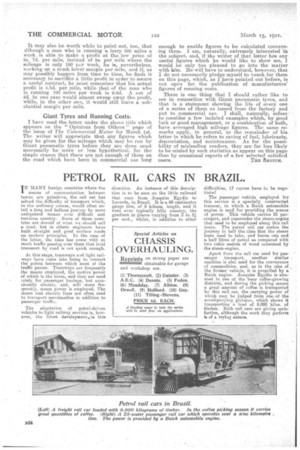PETROL RAIL CARS IN BRAZIL.
Page 28

If you've noticed an error in this article please click here to report it so we can fix it.
IN MANY foreign countries where the
means of communication between towns are primitive, the rail car has solved the difficulty of transport which, in the ordinary course, would often entail a long and tedious journey by more antiquated means over difficult and tortuous country. Some of these countries are devoid of what we should call a road, but in others engineers have built straight and good surface roads on modern principles. In the case of the latter, the time has come with so much traffic passing over them that local transport by read is not quick enough.
At this stage, .tramways and light railways have come into being to connect the points between which most of the traffic passes. Tramways are frequently the means employed, the motive power of which is the horse, and they are used Eo!ely for passenger haulage, but occasionally electric, and, still more frequently, steam power is employed. The steam and electric lines are often used to transport merchandise in addition to passenger traffic.
The adaptation of petrol-driven vehicles to light railway services is, however, the latest develepmento ia this direction. An instance of this description is to be seee on the little railroad that runs from Joa.quim Egydio to Lacerda, in Brazil. It is a 60 centimetre gauge line, of 9 khan's. length, and it runs over typically hilly country, the gradient in places varying from .3 to 3; per cent., whilst, in addition to other difficulties, 17 carves have to be nego
tiated .
The passenger vehicle employed for this service is a specially constructed tramcar, in which a Buick automobile engine is used for providing the means of power. This vehicle carries 25 passengers, and supersedes the steam-engine that used to be employed along this rail mute. The petrel rail car makes the journey in half the time that the steam train used to take, and burns one and a. half litres of petrol as compared with two cubic metres of wood consumed by the steam-engine.
Apart from the rail car used for passenger transport, another similar machine is also used for the conveyance of commodities, and, as in the case of tho former vehicle, it is propelled by a Buick engine. Joaquim Egydio is situated in one of the busy coffee-growing districts, and during the picking season a great amount of coffee is transported by this rail car, the carrying power of whicit may be judged from one of the accompanying pictures, which shows it transporting a load of 8,000 kilos. of timber. Both rail cars are giving satisfaction, although the work they perform is of a tryi.ig nature.
































